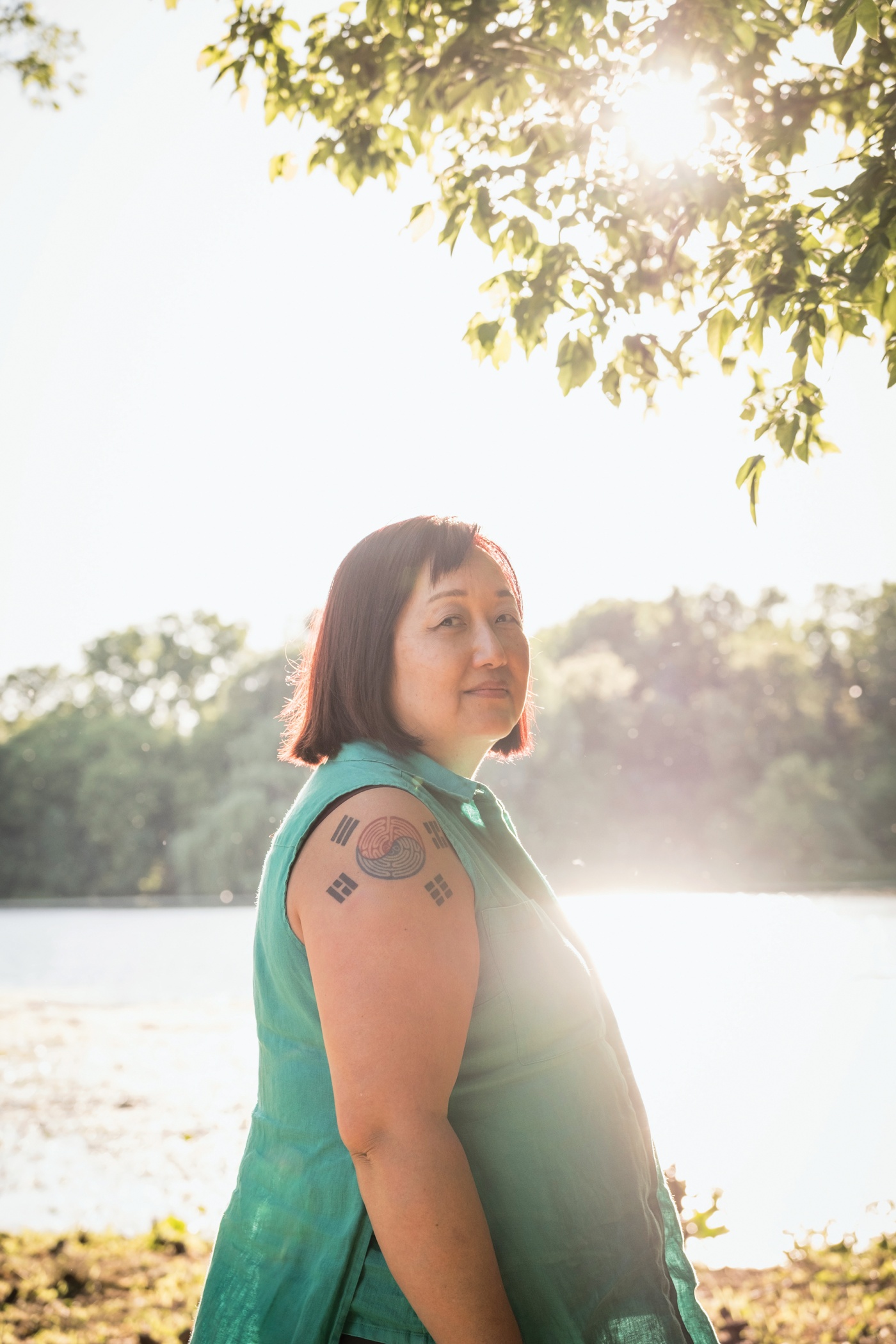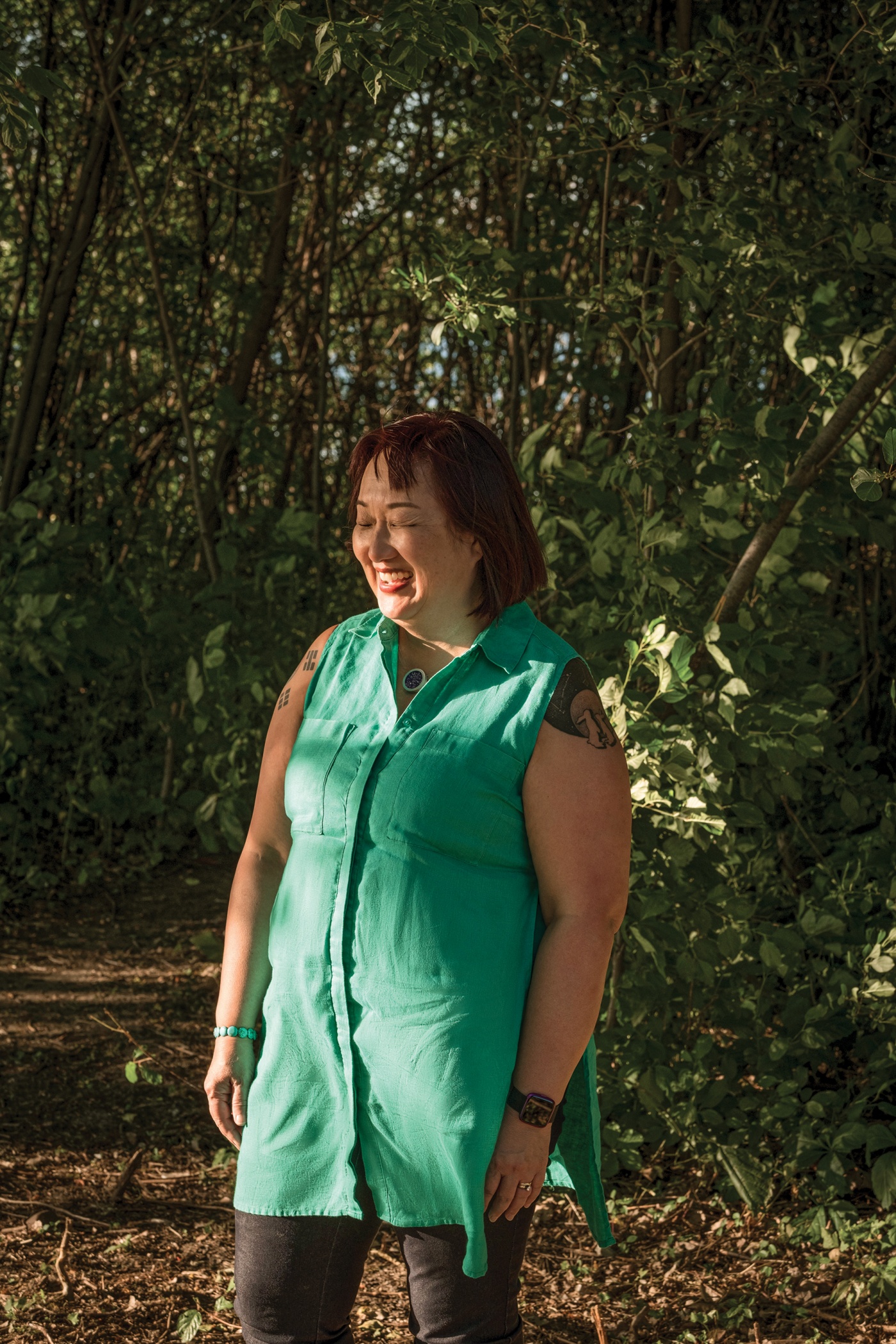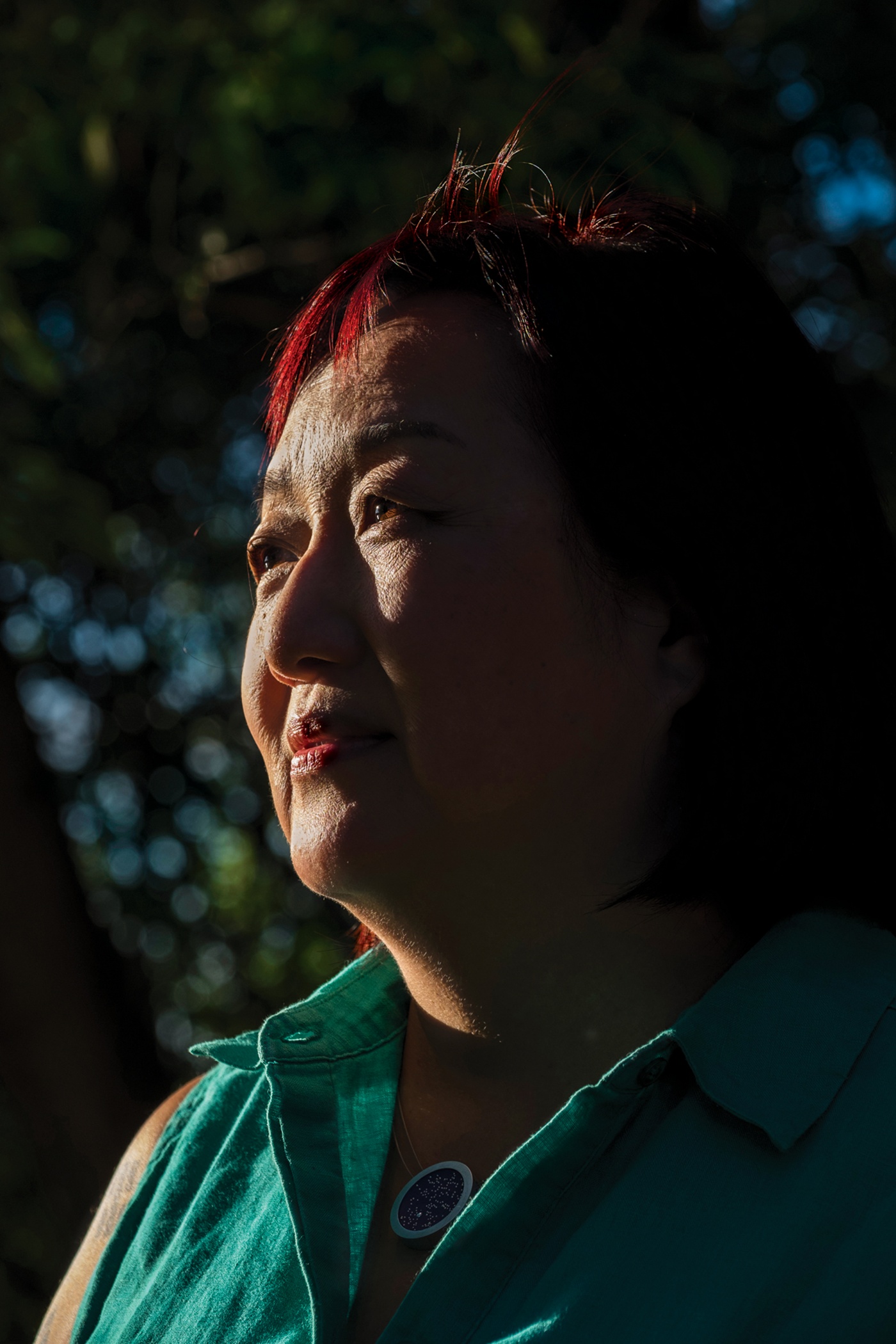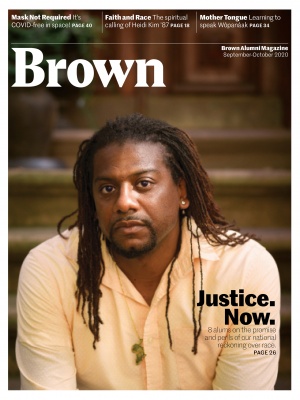Walking the Labyrinth
For Heidi Kim ’87, combating racism is a lifelong practice deeply rooted in her Christian faith

Heidi Kim ’87 is skeptical. She’s tired of the images, the constant stream of soldiers and tear gas and protesters thrown to the ground, weeping and gasping for breath. “I call it people-of-color grief porn for the white gaze,” she says. “All of it, including the video where George Floyd gets killed.”
She’s skeptical of the protesters, the well-meaning, passionate, progressive folks who “show up with this attitude, like, Gosh, things really are bad. But hey, now that I’m paying attention, we can fix it!” She’s skeptical of the corporations, who, a week after protests erupted, started spamming their customers with emails vowing support for Black Lives Matter. She’s skeptical of outrage. “Look, I get it. There’s plenty to be outraged about. But there’s a distinction between rage and outrage. Rage comes from having a history,
from experiencing the same thing again and again. Outrage—well, it’s exhausting. The performance of outrage takes so much energy. It’s not sustainable. And it dissipates so, so quickly.”
She’s skeptical of the trial. “I was in Los Angeles in 1992. If this mirrors that, the trial will be moved out of the Twin Cities, to some rural—read that as ‘white’—community. And it’s really, really hard to get convictions of police officers. Lots of police officers have killed lots of Black men and women and gotten off free.” And if the officers who killed George Floyd are convicted? “I worry that everyone will just say, Oh, wow, justice is served! Now I can go back to life as it was. But that’s not how systemic racism works. It’s not about one court case, one conviction, one city. What’s happening now is just the tiniest tip of the iceberg.”
She’s even skeptical of herself. “As a Korean person who moved to Minneapolis last summer, my role is not to tell anybody what they should be doing. I’m new here. I don’t know this city. But to be in a place of learning, trying to build relationships, so that I’m not the problem…to try to help with what I’ve got from where I am….” She trails off. “Right now, in this moment, it feels like I don’t have a whole hell of a lot.”
Faith and race From 2014 to 2019, it was Kim’s job as a national staff officer for the Episcopal Church to work on issues of racial justice, traveling the U.S. to help facilitate the type of conversation the nation is suddenly having right now. Since August of last year, she’s been the director of the Melrose Family Center for Servant Leadership at the Breck School, a P-12 Episcopal school in Minneapolis. Kim is devout and irreverent, often in the same sentence. She swears a lot. More than once, she tells me she’s a “disobedient layperson.” She’s a person of deep faith, a tireless crusader for social justice, a professional soprano, a consummate extrovert, an Episcopalian, a Red Sox fan, a mother and wife and daughter. She has a fantastic sense of humor and a wicked set of tattoos. And she considers herself—and her faith—works in perpetual progress.
Kim grew up in a remarkable family. Her parents each came to the United States on international college scholarships; eventually, they met and married in New York, where Kim’s mother was getting a master’s in divinity from Union Theological Seminary and her father was studying dentistry at NYU. Bill, Heidi’s oldest brother, was born in New York. The family then moved back to Korea, where Heidi and her middle brother Jim Yong Kim ’82 were born, and emigrated permanently to the U.S. when Heidi was about a year old.
They ended up in Muscatine, Iowa. Kim’s father practiced dentistry and taught at the University of Iowa, while her mother pursued (and eventually got, at the age of 47) a PhD in East Asian philosophy and religion. “When I was in grade school, my mother felt a call to ordained ministry,” Kim recalls. “She went to the local Methodist pastor, who basically said, How dare you! What could an Oriental woman
possibly offer to God’s people?” After that, the Kims didn’t go to church. “Sometimes I went with friends. And I liked it! But you know, always with the understanding that churches were racist, misogynist, anti-immigrant, and so on.” She laughs. “Growing up, I was pretty closeted about my faith.”
Bill went to the University of Iowa for both undergrad and medical school, and the assumption was that Jim and Heidi would follow his lead. “In Korean families, the idea of a ‘good fit’ college doesn’t exist,” Kim says. “It didn’t occur to us to apply anywhere else. But then Jim and I did this summer medical research program at Iowa, and there were all these kids from the East Coast talking about the Ivy League, so Jim decided to transfer to Brown. He liked it, so I applied.”
Jim went on to get an MD/PhD from Harvard, cofound the global nonprofit Partners in Health, and become the first Asian American president of an Ivy League institution (Dartmouth). In 2003, he was awarded a MacArthur fellowship; from 2012 to 2019 he served as president of the World Bank. “When Jim got the MacArthur, my mom was like, ‘So, Heidi, you’re smarter than Jim. When are YOU going to win a genius grant?’” Kim laughs. “I mean, I’m the youngest. And I’m the only girl. But still. I have a lot of Asian American friends and colleagues who totally relate to that story.”
Brown turned out not to be a “good fit” for Heidi after all. “In the early ’80s, when I got there, Brown had this narrative of, Oh, we’re really inclusive, we’re really committed to diversity. But we knew that the director of admissions had been overheard saying, ‘Just give me any pre-med with the last name Kim and we’ll cut them.’ That was the story that we heard, coming in as Asian Americans—that they saw us as interchangeable, as stereotypes. All the Koreans want to be doctors.”

At Brown, Kim was active in what were then called the Sarah Doyle Women’s Center and the Third World Center. Yet even in those places, the University’s much-vaunted inclusivity and diversity often felt like a sham. At Sarah Doyle, Kim was explicitly tasked with “bringing in” more women of color, which felt exploitative—as if she were being told, Hey, we’re committed to diversity, but you do all the work. Meanwhile, Brown’s administration turned a blind eye to egregiously discriminatory acts. When a pink triangle was erected on the Green, “frat boys burned it down and pissed on it to put out the fire,” Kim remembers. “That was pretty awful. And in response the president, Howard Swearer, made a speech in which he said, The Brown community decries any form of violence or vandalism—including the defacing of library books. With a straight face!”
Part of the tension, Kim now thinks, came from the fact that many people within Brown were trying. The director of Sarah Doyle meant well. She’d opened the doors to women of color—she welcomed them, for crying out loud! Why weren’t they rushing gratefully in? But good intentions alone are never enough. “Whenever an old, traditional institution—like Brown, or the Episcopal Church—starts selling a narrative of inclusivity that’s still aspirational, there are going to be growing pains,” Kim says. “There’s going to be friction. And that friction can light a spark, and create light and warmth…or it can just burn shit down.”
A skeptical start After graduation, Kim headed to UCLA for a graduate degree in sociology. She sang in the university’s master chorale and traveled to France to work with legendary choral conductor Robert Shaw. It was life-changing. “We even recorded a CD that was nominated for a Grammy,” Kim says. “It was around that point that I started to say to myself, Yeah, I’m not going to finish this PhD.” By then she’d met and married her husband, Alec Campbell, “and Alec was going to finish his PhD, so I needed to get a job. And this woman I’d sung with said, My church needs a soprano, it’s a paid position, are you interested? I thought, well, churches are racist and misogynist and anti-immigrant. Still, if they pay me? Then I’ll go.”
The church that paid Kim to go was St. John’s Episcopal in South Central L.A. “It was just this amazingly warm place. The congregation was 95 percent African Caribbean, and everyone knew and cared about and looked after each other. We had wonderful priests.” To her surprise, she came to adore the service. “St. John’s is very traditional, very high church. I really fell in love with the deeply mysterious elements of the liturgy.” Without quite having meant to, she became a devoted member of an Episcopal congregation.
Over the next decade, Kim and Campbell had two daughters. They bounced east (to Boston and Maine, where both Kim and Campbell taught at Colby College) and then west again (to Seattle, where Kim took a job as diversity director at a Jesuit high school). It was the first time she’d worked within a religious institution, and she loved it. After years in secular academia, she realized she’d essentially gone back in the closet about her faith. But although the work itself was joyful, she sensed that, as a non-Catholic, there wasn’t much room for her to grow. When the Episcopal Church advertised for a newly created staff position to address issues of racial injustice, “it felt like they were describing a longing of the heart for me,” Kim says.
“She knows how to make people feel seen. She listens—really listens, with a kind of focused intelligence—before she even says a single word. And she has a remarkable gift for opening up the lens.”
She got the job. In June of 2014, the Episcopal Church hired Kim and the Reverend Charles Wynder Jr., together as Missioner for Racial Reconciliation and Missioner for Social Justice and Advocacy Engagement, respectively. (In essence, the Church split one position into two, each with a slightly different focus.) Kim started work on July 7; one month later, an African American teenager named Michael Brown was shot and killed by a white police officer in Ferguson, Missouri. Violence and chaos ensued. “Heidi was part of a team that came in quickly to offer support,” says Reverend Steven Lawler, rector of St. Stephen’s Episcopal Church in Ferguson. “Right away, it was clear that she had a phenomenally deep understanding of the dynamics of working in a community struggling with racial injustice.”
In the aftermath of Brown’s death, Lawler says, people who saw themselves as saviors rushed to Ferguson. They were zealous and passionate, eager to help heal a broken community, and though they were undeniably well-intentioned, their conviction that they knew exactly how to fix things left Lawler’s parishioners feeling condescended to and resentful. Kim was a striking exception. “Heidi’s so wise, humble, funny, quick, and smart, but it’s more than that,” Lawler says. “She knows how to make people feel seen. She listens—really listens, with a kind of focused intelligence—before she even says a single word. And she has a remarkable gift for opening up the lens.”
Opening up the lens, as Lawler puts it, roughly corresponds with what Episcopalians call the via media, or middle way. It doesn’t mean quite what a secular person might think. Taking the middle way doesn’t involve splitting the difference. It’s not about pushing opposing sides toward some mutually acceptable common ground, nor about dumbing down polarizing issues until they’re palatable to all. The via media, Kim explains, aims to help people engage in dialogue despite their differences. You’re not trying to get everyone to agree. “What you want is for people to be able to disagree without screaming at each other, insulting each other. I tell them, we are not called to fix this conflict. We are called to hold it, in all its complexity.” She pauses, and sighs. “It’s an incredibly tough thing to do right now, in the United States, when our political life is so polarized.”
Building relationships In the five years she worked for the Episcopal Church, Kim spent about half her time on the road. She’d touch down in parish after parish, instigating awkward, painful discussions about race and power and privilege. She spoke to people of color, some of whom felt that the fact of their race exonerated them automatically. She spoke to well-intentioned white people, “real social justice warriors,” who were certain they couldn’t possibly be part of the problem. And she let no one off the hook. Shortly after the 2016 election, she ascended the podium in front of a liberal, Northeastern diocese and told them, “Hillary Clinton is a beloved child of God.” As expected, the crowd went wild.

When they quieted, Kim stood for a long moment. Finally, she spoke again. “Donald Trump is a beloved child of God.” There was dead silence. Then someone in the audience said, “I guess beloved child of God is the new Bless your heart.”
Perhaps, but God is crucial to Kim’s work. When asked if “racial reconciliation,” a theological term that connotes reckoning, atonement, and justice, can be achieved in a secular context, she hesitates. “It can, but I think it’s harder.” She has learned not to be afraid of theological language. “I’m calling myself a Christian. That means I’m committed to the idea that all people are beloved children of God. God loves all people, whether I think they deserve it or not. God even loves white supremacists.” She takes a deep breath. “I’m not saying everyone should do it this way. But this is the only way I can do it. For me, accountability has to come through the lens of faith. Because it’s too easy for me to dismiss people that I don’t agree with, unless I’m continually thinking of everyone as beloved children of God—whom I am also called to love.”
AFTER SEVERAL MONTHS on the job, Kim and Wynder became convinced that there’s no foolproof way—no program or instruction manual—to heal the wounds and bridge the gaps caused by institutional racism. The path toward reconciliation can’t be summed up in a handy little checklist—complete these seven actions, and you’re magically bias-free! “Saying you’ve gone through sensitivity training and now you’re no longer racist is like me saying, ‘Hey, I worked out one time in 1994, so I’m good,’” Kim quips. To teach reconciliation properly, they’d need to emphasize both the unique aspect of each person’s journey as well as the ongoing nature of the task. Eventually, their team came up with a concept—Becoming Beloved Community—and an image—the labyrinth.
Labyrinths exist in many cultures and contexts. For Christians, walking a labyrinth as a symbolic pilgrimage dates back at least to the Middle Ages. (There’s a labyrinth laid into the cathedral floor at Chartres.) Christian labyrinths are not mazes to find your way out of, nor puzzles to solve. There are multiple entrances and no correct path; as you tread your chosen circuit, you meander and reverse in ways that defy linear progress. One minute you’re headed straight for the center, and the next you’re turned back the way you came. It’s a powerful metaphor for faith.
It’s also a profound and sublime way to conceptualize the process of reconciliation, of forming what Episcopalians call “right relationship” with one another and with God. “There’s no moment you can say you’ve arrived,” Kim says. “Sometimes progress feels like backsliding. Five years ago, I’d have said I’m almost there. Now?” She laughs. “In my job at the Episcopal Church, I realized that relationships mattered more than any project or task. Building relationships with other people, with God, was the real work, more than creating a program or a curriculum or whatever it was. And it’s the relationships, more than the project itself, that are transformative. And then I realized that I really, really missed being able to have that with young people.”
Leading with youth Leaving her prestigious, international job at the Episcopal Church to work in a small Midwestern school may seem, to some, like a demotion or a cop-out; to Kim, it feels like another fortuitous reversal along her labyrinthine path. With her sixth-grade students, who are younger than any she’s ever taught before, she’s exploring the very notion of power; the lessons she’s learning dovetail with and expand on concepts she explored in the church. “In the servant leadership model, mentors can be younger than you,” she explains. “Historically, people have led in different ways. I kind of want to challenge the notion that, say, women of color are only successful when we occupy positions at the tops of organizations. If all you’re thinking about is your own ambition, then what do you do when you get there? Does that mean your spiritual trajectory has ended?
There’s a moment of opportunity in the midst of tragedy, Kim believes, when people’s hearts have been broken open. And there’s a chance, at that moment, to invite them into a different way of thinking.
“We don’t all need to be bishops,” she says firmly. “In my last position, I’d go around inciting people to articulate their dreams for their own communities. But I never got to stick around to follow through. Once they’d figured it out, I was off to the next group, asking, ‘So, what’s your dream?’ After a while, I realized that I really longed to be in a community long-term.”
Classes at the Breck School ended the week George Floyd was killed. But students who wanted to keep talking formed a discussion group on their own; Kim has been meeting with them virtually. “I would say that most sixth graders have some moral clarity,” she says. “They’re able to go with the complexity of it all. They can say, I’m sad that all those businesses
have burned down, and I’m sadder that George Floyd is dead. They can hold on to both of those feelings without thinking that they have to choose. And it’s all ahead of them, you know? How they come to terms with all of this, what they decide to do about it…this year will be a defining moment for them. A lot of them are sharing with me that they want to be part of a solution going forward. But right now, they’re not trying to fix everything. They’re asking questions, and listening, and trying to understand.”
There’s a moment of opportunity in the midst of tragedy, Kim believes, when people’s hearts have been broken open. And there’s a chance, at that moment, to invite them into a different way of thinking. “My first summer in Minneapolis is taking place amid a pandemic and a major racial justice uprising,” she says. “And so what I ask myself is this: Why am I here? What is God expecting of me, what is the Holy Spirit demanding of me in this moment? In this city that’s now mine, where all of this suffering is taking place, how can I use this as an opportunity to deepen people’s understanding?
“If there’s anything at all I bring to this, it’s the knowledge that this isn’t going to go away quickly. You don’t undo racism by dismantling one police department. In Ferguson, for instance—the immediate violence may have ended, but the underlying racism is still there. And so, the question becomes: How can I use the knowledge that I have to help this community find the courage to keep fighting? And the strength not to give up when the outrage wears out?”
Fernanda Moore ’90 lives in Swarthmore, PA. She is at work on a novel.





